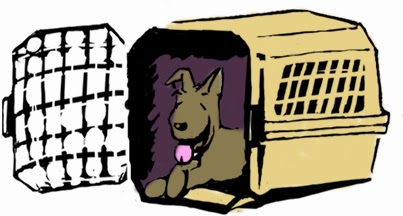What is Crate Training? Crate Training is the process of teaching your dog to accept being crated or confined. This is important and useful for several reasons:
1. To teach your dog to accept confinement and to settle down
At some point in your dog’s life, it may be necessary to confine him. It may be because you want to travel with him, or because you’d like to keep him safely out of the way for a few hours, or because you have guests over that are afraid of or allergic to dogs and would rather not have him around while they visit you. This is why all dogs, even those considered to be well-behaved, should be taught to accept confinement.
2. To teach your dog to accept alone time
It is also likely that at some point your dog will experience being separated from you and/or the rest of the family. The crate is a tool you can use to practice short sessions of alone time, from which you will build up to longer and longer periods of separation and being away from you.
3. As a tool to help you with potty training your dog
Crates are great to use for potty training puppies and even older dogs. Dogs instinctively refrain from soiling their sleeping places – this is what a crate is to them. With proper crate training, potty accidents are prevented from happening around your household during potty training period.
4. As a tool to help develop a habit for chewing on appropriate chew items
You can also use the crate to show your dog what items are appropriate to chew on. While in confinement in his crate, leave him occupied by presenting him with an indestructible chew item such as a stuffed Kong. This relieves the dog of anxiety from being confined and left alone.
2 Basic Types of Crate
Wire Crate: Made out of metal. It looks like a cage but is collapsible
Better ventilation
Collapsible / easily stored
Disadvantages
May be noisy when dog moves around within
Not acceptable for airline travel
Plastic crate: Made out of hard plastic – with top and bottom parts that can be screwed or snapped together. Slats on the sides of plastic crates allow for ventilation, and a metal grill serves as a door.
May be used for airline travel
More den-like, some dogs feel safer in this type of crate
Less noise when animal moves around inside it
Disadvantages
Dark, unlit interior, some dogs prefer having more of a view
Limited ventilation
Size of Crate
The crate should be just big enough for your dog to sit, stand up and turn around in, and should have enough head- and leg-room. If you are buying a crate for a puppy, do not buy a huge crate for him to grow into. Having all that room may result in your puppy, sleeping on one side of the crate and going potty on the other side. You may need to buy a puppy-sized crate now and a larger one later. You could also purchase a crate that comes with dividers so you can gradually expand the puppy’s space as needed, or fill the extra space with a basket or box while the puppy is still too small for his adult-sized crate.
What’s Inside?
Crates should be lined with soft flooring such as a pillow or a blanket that the dog can lie down on/ This is especially important for wire crates. To keep your dog occupied while in confinement, you should also get your dog some nice indestructible and appropriately-sized chewtoys.
How Do I Introduce My Dog to the Crate?
When you first introduce your dog to the crate, be sure the door is propped open so as not to swing shut by accident and spook your dog. If your dog doesn’t go in to explore on his own, place a few treat or his meal inside. Do not force your dog into the crate. Progress gradually to shutting your dog in the crate with a stuffed Kong or chew bone. Ideally, your dog should have a few days to get used to the crate before actually being locked inside and being required to sleep inside it.
The First Night 
Keep the crate where you want your dog to sleep, preferably by the side of your bed. For very young puppies that have no bladder control yet, it is best to keep him within hearing range so you will know if he needs to eliminate during the night. Most dogs will not mind being crated and whine less so long as they know that you are nearby.
The first night you crate your dog, gently help him in if necessary, then softly close the door. You may expect that your dog will whine, bark or throw a tantrum the first night in the crate. Do not reward this behavior by letting him out. Ignore him for a while, wait for a lull in his whining and only then – and if you feel that you really must – check on him or let him out. Remember to only approach the crate when your dog is calm and quiet.
The Potty Schedule
 For dogs that are not yet potty trained, maintain a regular schedule for taking your dog out to pee and poop. As a general rule of thumb, the number of hours that a young puppy can comfortably hold his urine is equivalent to the age in months: For example, a 1-month old puppy can hold it for an hour; a 2-month old puppy can hold it for 2 hours; a 3-month old puppy can hold it for 3 hours and so on. Unfortunately, this may mean that initially you will have to get up in the middle of the night to take him out to potty, although some puppies can make it through the night without being let out.
For dogs that are not yet potty trained, maintain a regular schedule for taking your dog out to pee and poop. As a general rule of thumb, the number of hours that a young puppy can comfortably hold his urine is equivalent to the age in months: For example, a 1-month old puppy can hold it for an hour; a 2-month old puppy can hold it for 2 hours; a 3-month old puppy can hold it for 3 hours and so on. Unfortunately, this may mean that initially you will have to get up in the middle of the night to take him out to potty, although some puppies can make it through the night without being let out.
Dogs that are 6-8 months or older should have sufficient bladder control that they only need to go relieve themselves around 3-4 times in a day. For more on potty training your puppy, CLICK HERE.
A Crate is for Short-Term Confinement Only
If you must leave your house for long periods of time it is recommended that you leave your untrained dog in a larger, long-term confinement area such as an exercise pen or any enclosed area in your house where your dog can’t get into any trouble by destroying no-no items. This long-term confinement area should also have an area, covered with your preferred potty substrate, where the dog can go to relieve himself while you are away and when no one can come to walk him or take him to his potty spot.
Do I Have to use the Crate throughout my Dog’s Entire Life?
If you’ve put enough time into training for home manners and basic obedience, your dog will become reliable around the house and can be trusted to be left unsupervised without getting into trouble. At such time, you can put the crate aside or simply leave it around the house and accessible to your dog as an optional sleeping and feeding area. The crate will also remain useful as your dog’s home away from home whenever you are traveling with him.

